CROATIAN PAVILION AT THE VENICE BIENNALE
Engaging with the theme of Adriano Pedrosa’s main exhibition for the Venice Biennale, Stranieri Ovunque—Foreigners Everywhere, Vlatka Horvat’s project for the Croatian Pavilion by the Means at Hand, curated by Antonia Majaca, exists as an accumulative exhibition of artworks by a wide-ranging group of international artists living as “foreigners,” reflecting on questions and urgencies of the diasporic experience.
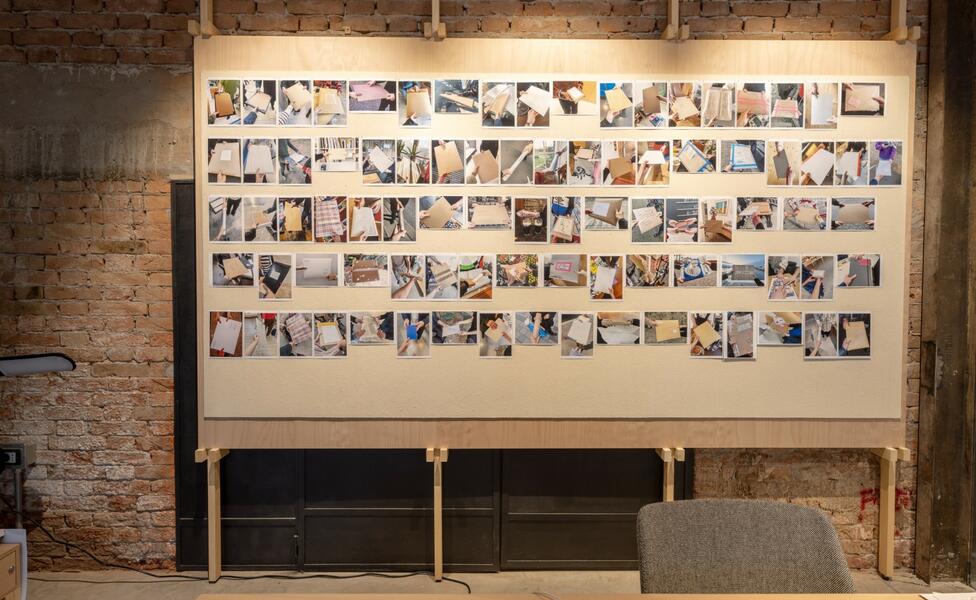
For the exhibition, Horvat is inviting artists living in diaspora all over the world to engage in a series of reciprocal exchanges of artworks and other materials, all of which are sent between Venice and other places by improvised means, with the help of various friends, acquaintances and even strangers travelling to Venice, who are enlisted as informal couriers for the project.
The title of the project—By the Means at Hand—refers to the improvised transport systems whereby individuals activate informal networks to deliver letters, parcels, documents, money, and other material goods to family members and others who live far away. While such practices are born out of social dispersal, migration, and displacement, the networks they give rise to build effectively on wider principles of solidarity, shared struggle, mutual support, and friendship—factors that the project emphasizes as prerequisites for co-existing with others, and as key elements in the toolkit for those living “in foreign lands.”
Situated within the intimate space of Fàbrica 33 in the Cannaregio—Fondamente Nove neighborhood of Venice, the Croatian Pavilion will also serve as Horvat’s temporary studio for the duration of the biennale.
-
Pavilion of CROATIA. By the Means at Hand. 60th International Art Exhibition - La Biennale di Venezia. Photo: Andrea Avezzù. Courtesy: La Biennale di Venezia
-
Pavilion of CROATIA. By the Means at Hand. 60th International Art Exhibition - La Biennale di Venezia. Photo: Andrea Avezzù. Courtesy: La Biennale di Venezia
-
Pavilion of CROATIA. By the Means at Hand. 60th International Art Exhibition - La Biennale di Venezia. Photo: Andrea Avezzù. Courtesy: La Biennale di Venezia
-
Pavilion of CROATIA. By the Means at Hand. 60th International Art Exhibition - La Biennale di Venezia. Photo: Andrea Avezzù. Courtesy: La Biennale di Venezia
-
Pavilion of CROATIA. By the Means at Hand. 60th International Art Exhibition - La Biennale di Venezia. Photo: Andrea Avezzù. Courtesy: La Biennale di Venezia
-
Pavilion of CROATIA. By the Means at Hand. 60th International Art Exhibition - La Biennale di Venezia. Photo: Andrea Avezzù. Courtesy: La Biennale di Venezia
-
Pavilion of CROATIA. By the Means at Hand. 60th International Art Exhibition - La Biennale di Venezia. Photo: Andrea Avezzù. Courtesy: La Biennale di Venezia
Vlatka Horvat is an artist working across a wide range of forms from sculpture, installation, drawing, collage, and photography to performance, video, writing, and publishing. Reconfiguring space and social relations at play in it, her projects often rework the precarious relationship between bodies, objects, materials, the built environment, and landscape. She has had exhibitions at institutions such as the Museum of Contemporary Art Zagreb, PEER (London), Kunsthalle Wien (Vienna), Hessel Museum—Bard Center for Curatorial Studies (Annandale-on-Hudson, NY), Stroom (The Hague), Bergen Kunsthall, the Kitchen (New York City) and MoMA PS1 (New York City), and her work has been included in the Croatian Pavilion at the 16th Architecture Biennale (Venice), Aichi Triennale (Nagoya), and the 11th Istanbul Biennale. Her performances have been commissioned by venues including HAU Hebbel am Ufer (Berlin), LIFT—London International Festival of Theatre, PACT Zollverein (Essen), Kaaitheater (Brussels), Fondation Cartier (Paris), and many others. Born in Croatia, she moved to the United States as a teenager and spent twenty years there. She currently lives in London, UK.
May interest you
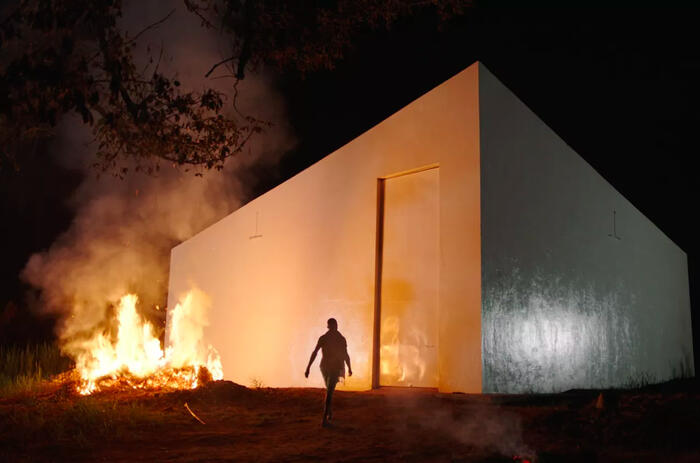
The title of the 60th International Art Exhibition of the Biennale di Venezia, "Stranieri Ovunque", refers, in part, to foreignness as the inherent nature of the subject. Understood in this way, the national pavilions of Spain, the Netherlands and the United Kingdom exhibit artistic proposals that develop the theme of colonialism and reconstruct histories, remedy ties between identity and territory, and explore the dramatic plurality of this potent historical axis. That said, this review does not intend to unveil or unpack the most unjust transcendental truths, but merely to reflect on the musings of others.
THREE PAVILIONS AT BIENNALE 2024 THAT EXPLORE THEIR OWN COLONIAL PASTS
The title of the 60th International Art Exhibition of the Biennale di Venezia, "Stranieri Ovunque", refers, in part, to foreignness as the inherent nature of the subject. Understood in this way, the national pavilions of Spain, the Netherlands and the United Kingdom exhibit artistic proposals that develop the theme of colonialism and reconstruct histories, remedy ties between identity and territory, and explore the dramatic plurality of this potent historical axis. That said, this review does not intend to unveil or unpack the most unjust transcendental truths, but merely to reflect on the musings of others.

The title of the 60th International Art Exhibition of the Biennale di Venezia, "Stranieri Ovunque", refers, in part, to foreignness as the inherent nature of the subject. Understood in this way, the national pavilions of Spain, the Netherlands and the United Kingdom exhibit artistic proposals that develop the theme of colonialism and reconstruct histories, remedy ties between identity and territory, and explore the dramatic plurality of this potent historical axis. That said, this review does not intend to unveil or unpack the most unjust transcendental truths, but merely to reflect on the musings of others.
THREE PAVILIONS AT BIENNALE 2024 THAT EXPLORE THEIR OWN COLONIAL PASTS
The title of the 60th International Art Exhibition of the Biennale di Venezia, "Stranieri Ovunque", refers, in part, to foreignness as the inherent nature of the subject. Understood in this way, the national pavilions of Spain, the Netherlands and the United Kingdom exhibit artistic proposals that develop the theme of colonialism and reconstruct histories, remedy ties between identity and territory, and explore the dramatic plurality of this potent historical axis. That said, this review does not intend to unveil or unpack the most unjust transcendental truths, but merely to reflect on the musings of others.
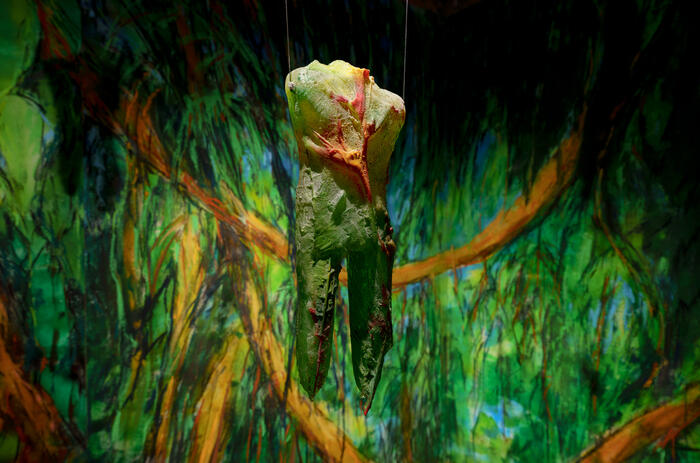
The Panama Pavilion at the 2024 Venice Art Biennale arises as a profound reflection on the enduring traces that migration leaves on individuals and their surroundings. Entitled Traces: On the Body and on the Land, this exhibition echoes the current migration crisis with a particular focus on the Panamanian context, interpreted by four artists through drawings, paintings, collages, glass sculptures, and installations.
TRACES – PANAMÁ’S DEBUT AT THE VENICE BIENNALE
The Panama Pavilion at the 2024 Venice Art Biennale arises as a profound reflection on the enduring traces that migration leaves on individuals and their surroundings. Entitled Traces: On the Body and on the Land, this exhibition echoes the current migration crisis with a particular focus on the Panamanian context, interpreted by four artists through drawings, paintings, collages, glass sculptures, and installations.
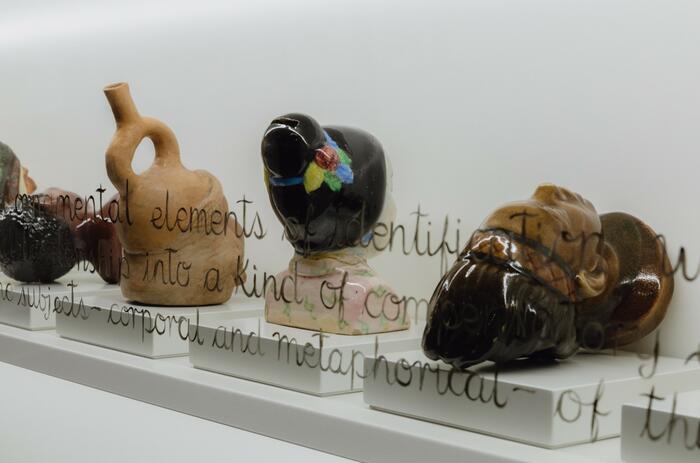
Spanish-Peruvian artist Sandra Gamarra Heshiki represents Spain at the Venice Biennale. It is the first time in 60 editions that an artist not born in Spain does so. Her project Pinacoteca migrante (Migrant gallery), questions colonial narratives and historical modes of representation.
PINACOTECA MIGRANTE: SPAIN AT THE VENICE BIENNALE
Spanish-Peruvian artist Sandra Gamarra Heshiki represents Spain at the Venice Biennale. It is the first time in 60 editions that an artist not born in Spain does so. Her project Pinacoteca migrante (Migrant gallery), questions colonial narratives and historical modes of representation.
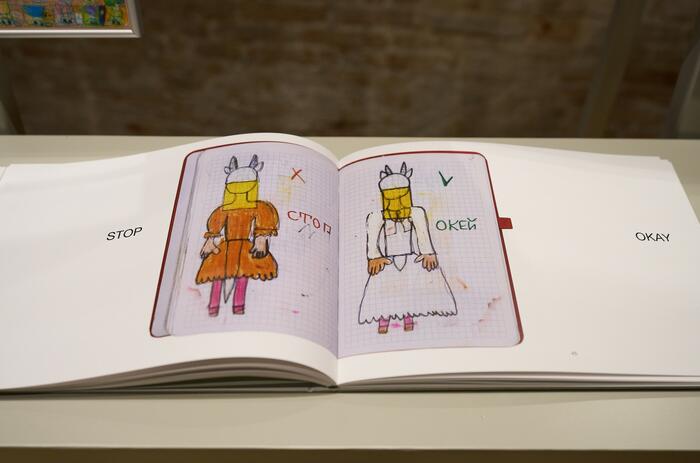
The Ukranian Pavilion addresses the othering effect of war, two years into the Russian Invasion, in Net Making at the 60th Venice Biennale.
UKRAINE AND THE EFECT OF WAR AT VENICE BIENNALE
The Ukranian Pavilion addresses the othering effect of war, two years into the Russian Invasion, in Net Making at the 60th Venice Biennale.
It takes an Island to Feel this Good is Darja Bajagić’s exhibition for the Montenegro pavilion at Venice Biennale 2024. Curated by Ana Simona Zelenović and organized by the Museum of Contemporary Art of Montenegro at the initiative of commissioner Vladislav Šćepanović, the exhibition will present a critical consideration of the culture of collective memory and the relationship to shared historical heritage.
ICONOGRAPHY, MEMORY AND HISTORY - THE MONTENEGRO PAVILION
It takes an Island to Feel this Good is Darja Bajagić’s exhibition for the Montenegro pavilion at Venice Biennale 2024. Curated by Ana Simona Zelenović and organized by the Museum of Contemporary Art of Montenegro at the initiative of commissioner Vladislav Šćepanović, the exhibition will present a critical consideration of the culture of collective memory and the relationship to shared historical heritage.
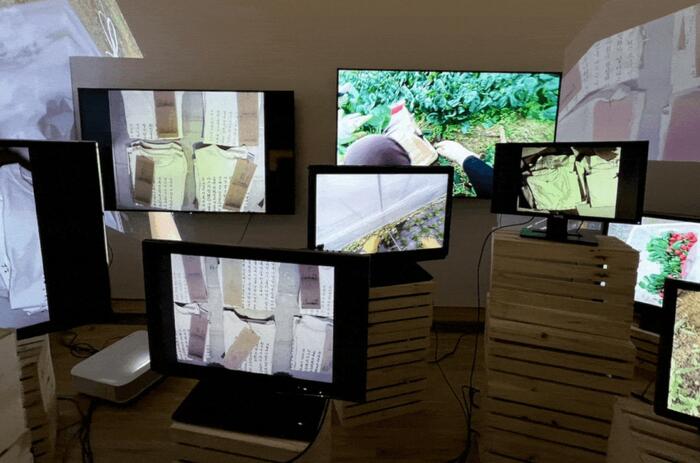
apexart is soliciting idea-based group exhibition proposals for its NYC open call October 1–31, 2024. Five winning proposals will receive up to a 10,000 USD exhibition budget and become apexart exhibitions at the NYC space as part of the 2025–26 exhibition season. Curators, artists, writers, and creative individuals, regardless of experience level or location, are invited to submit a proposal online.
OPEN CALL FOR APEXART’S GROUP EXHIBITION AT NYC
apexart is soliciting idea-based group exhibition proposals for its NYC open call October 1–31, 2024. Five winning proposals will receive up to a 10,000 USD exhibition budget and become apexart exhibitions at the NYC space as part of the 2025–26 exhibition season. Curators, artists, writers, and creative individuals, regardless of experience level or location, are invited to submit a proposal online.
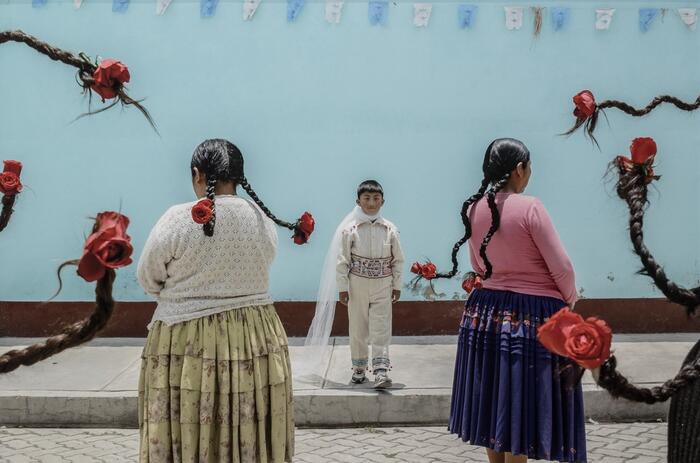
Why highlight stories that often remain on the periphery of artistic discourse? Adriano Pedrosa justifies his curatorial decision with works by 331 artists -mostly from the global south- that open the way to powerful narratives. Finally, we see the axis being twisted. It is difficult to escape the white gaze, more so to move authentically through a Eurocentric space. Given this, the communicative reach of figuration serves to challenge the symbolic order of domination and destabilize the colonial project. The stories that are made explicit and the narratives of magic and everyday life help to recognize without revictimizing.
STORIES FROM THE SOUTH – THE VENICE BIENNALE TURNS AROUND ITS AXIS
Why highlight stories that often remain on the periphery of artistic discourse? Adriano Pedrosa justifies his curatorial decision with works by 331 artists -mostly from the global south- that open the way to powerful narratives. Finally, we see the axis being twisted. It is difficult to escape the white gaze, more so to move authentically through a Eurocentric space. Given this, the communicative reach of figuration serves to challenge the symbolic order of domination and destabilize the colonial project. The stories that are made explicit and the narratives of magic and everyday life help to recognize without revictimizing.
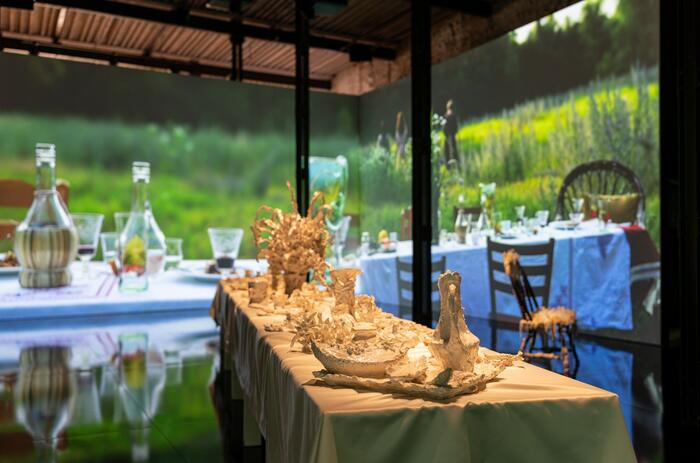
The Mexico Pavilion at the Venice Biennale 2024 proposes an immersive experience that invites the viewer to reflect on the act of migrating and its impact on identity and sense of belonging. As we marched away, we were always coming back is Erick Meyenberg's project curated by Tania Ragasol. It includes elements created in Mexico, Italy and Albania.
THE PATH OF MEMORIES – MEXICO AT THE BIENNALE
The Mexico Pavilion at the Venice Biennale 2024 proposes an immersive experience that invites the viewer to reflect on the act of migrating and its impact on identity and sense of belonging. As we marched away, we were always coming back is Erick Meyenberg's project curated by Tania Ragasol. It includes elements created in Mexico, Italy and Albania.
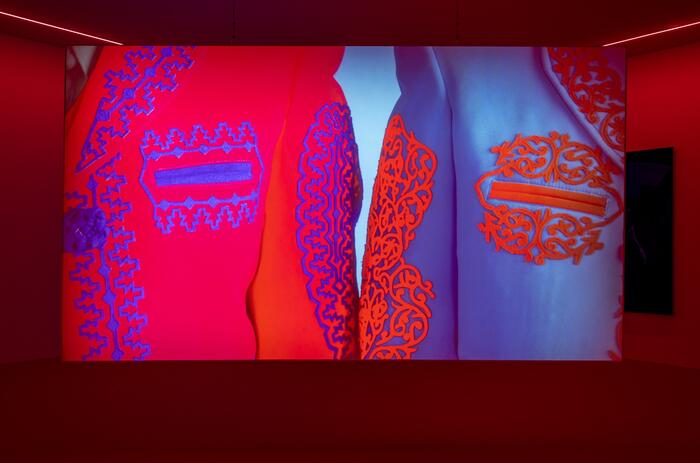
The voices of Latin American artists emerge strongly in this 2024 edition of the Venice Biennale. Claudia Alarcón, Julia Isídrez and Juana Marta Rodas, Ana Segovia, Frieda Toranzo Jaeger and Claudia Andújar lead viewers on a profound journey through their cultural heritage and unique artistic practices.
FIVE LATIN AMERICAN ARTISTS EXHIBITING FOR THE FIRST TIME AT THE VENICE BIENNALE
The voices of Latin American artists emerge strongly in this 2024 edition of the Venice Biennale. Claudia Alarcón, Julia Isídrez and Juana Marta Rodas, Ana Segovia, Frieda Toranzo Jaeger and Claudia Andújar lead viewers on a profound journey through their cultural heritage and unique artistic practices.

The title of the 60th International Art Exhibition of the Biennale di Venezia, "Stranieri Ovunque", refers, in part, to foreignness as the inherent nature of the subject. Understood in this way, the national pavilions of Spain, the Netherlands and the United Kingdom exhibit artistic proposals that develop the theme of colonialism and reconstruct histories, remedy ties between identity and territory, and explore the dramatic plurality of this potent historical axis. That said, this review does not intend to unveil or unpack the most unjust transcendental truths, but merely to reflect on the musings of others.
THREE PAVILIONS AT BIENNALE 2024 THAT EXPLORE THEIR OWN COLONIAL PASTS
The title of the 60th International Art Exhibition of the Biennale di Venezia, "Stranieri Ovunque", refers, in part, to foreignness as the inherent nature of the subject. Understood in this way, the national pavilions of Spain, the Netherlands and the United Kingdom exhibit artistic proposals that develop the theme of colonialism and reconstruct histories, remedy ties between identity and territory, and explore the dramatic plurality of this potent historical axis. That said, this review does not intend to unveil or unpack the most unjust transcendental truths, but merely to reflect on the musings of others.

The Panama Pavilion at the 2024 Venice Art Biennale arises as a profound reflection on the enduring traces that migration leaves on individuals and their surroundings. Entitled Traces: On the Body and on the Land, this exhibition echoes the current migration crisis with a particular focus on the Panamanian context, interpreted by four artists through drawings, paintings, collages, glass sculptures, and installations.
TRACES – PANAMÁ’S DEBUT AT THE VENICE BIENNALE
The Panama Pavilion at the 2024 Venice Art Biennale arises as a profound reflection on the enduring traces that migration leaves on individuals and their surroundings. Entitled Traces: On the Body and on the Land, this exhibition echoes the current migration crisis with a particular focus on the Panamanian context, interpreted by four artists through drawings, paintings, collages, glass sculptures, and installations.

Spanish-Peruvian artist Sandra Gamarra Heshiki represents Spain at the Venice Biennale. It is the first time in 60 editions that an artist not born in Spain does so. Her project Pinacoteca migrante (Migrant gallery), questions colonial narratives and historical modes of representation.
PINACOTECA MIGRANTE: SPAIN AT THE VENICE BIENNALE
Spanish-Peruvian artist Sandra Gamarra Heshiki represents Spain at the Venice Biennale. It is the first time in 60 editions that an artist not born in Spain does so. Her project Pinacoteca migrante (Migrant gallery), questions colonial narratives and historical modes of representation.

The Ukranian Pavilion addresses the othering effect of war, two years into the Russian Invasion, in Net Making at the 60th Venice Biennale.
UKRAINE AND THE EFECT OF WAR AT VENICE BIENNALE
The Ukranian Pavilion addresses the othering effect of war, two years into the Russian Invasion, in Net Making at the 60th Venice Biennale.
It takes an Island to Feel this Good is Darja Bajagić’s exhibition for the Montenegro pavilion at Venice Biennale 2024. Curated by Ana Simona Zelenović and organized by the Museum of Contemporary Art of Montenegro at the initiative of commissioner Vladislav Šćepanović, the exhibition will present a critical consideration of the culture of collective memory and the relationship to shared historical heritage.
ICONOGRAPHY, MEMORY AND HISTORY - THE MONTENEGRO PAVILION
It takes an Island to Feel this Good is Darja Bajagić’s exhibition for the Montenegro pavilion at Venice Biennale 2024. Curated by Ana Simona Zelenović and organized by the Museum of Contemporary Art of Montenegro at the initiative of commissioner Vladislav Šćepanović, the exhibition will present a critical consideration of the culture of collective memory and the relationship to shared historical heritage.

apexart is soliciting idea-based group exhibition proposals for its NYC open call October 1–31, 2024. Five winning proposals will receive up to a 10,000 USD exhibition budget and become apexart exhibitions at the NYC space as part of the 2025–26 exhibition season. Curators, artists, writers, and creative individuals, regardless of experience level or location, are invited to submit a proposal online.
OPEN CALL FOR APEXART’S GROUP EXHIBITION AT NYC
apexart is soliciting idea-based group exhibition proposals for its NYC open call October 1–31, 2024. Five winning proposals will receive up to a 10,000 USD exhibition budget and become apexart exhibitions at the NYC space as part of the 2025–26 exhibition season. Curators, artists, writers, and creative individuals, regardless of experience level or location, are invited to submit a proposal online.

Why highlight stories that often remain on the periphery of artistic discourse? Adriano Pedrosa justifies his curatorial decision with works by 331 artists -mostly from the global south- that open the way to powerful narratives. Finally, we see the axis being twisted. It is difficult to escape the white gaze, more so to move authentically through a Eurocentric space. Given this, the communicative reach of figuration serves to challenge the symbolic order of domination and destabilize the colonial project. The stories that are made explicit and the narratives of magic and everyday life help to recognize without revictimizing.
STORIES FROM THE SOUTH – THE VENICE BIENNALE TURNS AROUND ITS AXIS
Why highlight stories that often remain on the periphery of artistic discourse? Adriano Pedrosa justifies his curatorial decision with works by 331 artists -mostly from the global south- that open the way to powerful narratives. Finally, we see the axis being twisted. It is difficult to escape the white gaze, more so to move authentically through a Eurocentric space. Given this, the communicative reach of figuration serves to challenge the symbolic order of domination and destabilize the colonial project. The stories that are made explicit and the narratives of magic and everyday life help to recognize without revictimizing.

The Mexico Pavilion at the Venice Biennale 2024 proposes an immersive experience that invites the viewer to reflect on the act of migrating and its impact on identity and sense of belonging. As we marched away, we were always coming back is Erick Meyenberg's project curated by Tania Ragasol. It includes elements created in Mexico, Italy and Albania.
THE PATH OF MEMORIES – MEXICO AT THE BIENNALE
The Mexico Pavilion at the Venice Biennale 2024 proposes an immersive experience that invites the viewer to reflect on the act of migrating and its impact on identity and sense of belonging. As we marched away, we were always coming back is Erick Meyenberg's project curated by Tania Ragasol. It includes elements created in Mexico, Italy and Albania.

The voices of Latin American artists emerge strongly in this 2024 edition of the Venice Biennale. Claudia Alarcón, Julia Isídrez and Juana Marta Rodas, Ana Segovia, Frieda Toranzo Jaeger and Claudia Andújar lead viewers on a profound journey through their cultural heritage and unique artistic practices.
FIVE LATIN AMERICAN ARTISTS EXHIBITING FOR THE FIRST TIME AT THE VENICE BIENNALE
The voices of Latin American artists emerge strongly in this 2024 edition of the Venice Biennale. Claudia Alarcón, Julia Isídrez and Juana Marta Rodas, Ana Segovia, Frieda Toranzo Jaeger and Claudia Andújar lead viewers on a profound journey through their cultural heritage and unique artistic practices.

The title of the 60th International Art Exhibition of the Biennale di Venezia, "Stranieri Ovunque", refers, in part, to foreignness as the inherent nature of the subject. Understood in this way, the national pavilions of Spain, the Netherlands and the United Kingdom exhibit artistic proposals that develop the theme of colonialism and reconstruct histories, remedy ties between identity and territory, and explore the dramatic plurality of this potent historical axis. That said, this review does not intend to unveil or unpack the most unjust transcendental truths, but merely to reflect on the musings of others.
THREE PAVILIONS AT BIENNALE 2024 THAT EXPLORE THEIR OWN COLONIAL PASTS
The title of the 60th International Art Exhibition of the Biennale di Venezia, "Stranieri Ovunque", refers, in part, to foreignness as the inherent nature of the subject. Understood in this way, the national pavilions of Spain, the Netherlands and the United Kingdom exhibit artistic proposals that develop the theme of colonialism and reconstruct histories, remedy ties between identity and territory, and explore the dramatic plurality of this potent historical axis. That said, this review does not intend to unveil or unpack the most unjust transcendental truths, but merely to reflect on the musings of others.

The Panama Pavilion at the 2024 Venice Art Biennale arises as a profound reflection on the enduring traces that migration leaves on individuals and their surroundings. Entitled Traces: On the Body and on the Land, this exhibition echoes the current migration crisis with a particular focus on the Panamanian context, interpreted by four artists through drawings, paintings, collages, glass sculptures, and installations.
TRACES – PANAMÁ’S DEBUT AT THE VENICE BIENNALE
The Panama Pavilion at the 2024 Venice Art Biennale arises as a profound reflection on the enduring traces that migration leaves on individuals and their surroundings. Entitled Traces: On the Body and on the Land, this exhibition echoes the current migration crisis with a particular focus on the Panamanian context, interpreted by four artists through drawings, paintings, collages, glass sculptures, and installations.

Spanish-Peruvian artist Sandra Gamarra Heshiki represents Spain at the Venice Biennale. It is the first time in 60 editions that an artist not born in Spain does so. Her project Pinacoteca migrante (Migrant gallery), questions colonial narratives and historical modes of representation.
PINACOTECA MIGRANTE: SPAIN AT THE VENICE BIENNALE
Spanish-Peruvian artist Sandra Gamarra Heshiki represents Spain at the Venice Biennale. It is the first time in 60 editions that an artist not born in Spain does so. Her project Pinacoteca migrante (Migrant gallery), questions colonial narratives and historical modes of representation.

The Ukranian Pavilion addresses the othering effect of war, two years into the Russian Invasion, in Net Making at the 60th Venice Biennale.
UKRAINE AND THE EFECT OF WAR AT VENICE BIENNALE
The Ukranian Pavilion addresses the othering effect of war, two years into the Russian Invasion, in Net Making at the 60th Venice Biennale.
It takes an Island to Feel this Good is Darja Bajagić’s exhibition for the Montenegro pavilion at Venice Biennale 2024. Curated by Ana Simona Zelenović and organized by the Museum of Contemporary Art of Montenegro at the initiative of commissioner Vladislav Šćepanović, the exhibition will present a critical consideration of the culture of collective memory and the relationship to shared historical heritage.
ICONOGRAPHY, MEMORY AND HISTORY - THE MONTENEGRO PAVILION
It takes an Island to Feel this Good is Darja Bajagić’s exhibition for the Montenegro pavilion at Venice Biennale 2024. Curated by Ana Simona Zelenović and organized by the Museum of Contemporary Art of Montenegro at the initiative of commissioner Vladislav Šćepanović, the exhibition will present a critical consideration of the culture of collective memory and the relationship to shared historical heritage.

apexart is soliciting idea-based group exhibition proposals for its NYC open call October 1–31, 2024. Five winning proposals will receive up to a 10,000 USD exhibition budget and become apexart exhibitions at the NYC space as part of the 2025–26 exhibition season. Curators, artists, writers, and creative individuals, regardless of experience level or location, are invited to submit a proposal online.
OPEN CALL FOR APEXART’S GROUP EXHIBITION AT NYC
apexart is soliciting idea-based group exhibition proposals for its NYC open call October 1–31, 2024. Five winning proposals will receive up to a 10,000 USD exhibition budget and become apexart exhibitions at the NYC space as part of the 2025–26 exhibition season. Curators, artists, writers, and creative individuals, regardless of experience level or location, are invited to submit a proposal online.

Why highlight stories that often remain on the periphery of artistic discourse? Adriano Pedrosa justifies his curatorial decision with works by 331 artists -mostly from the global south- that open the way to powerful narratives. Finally, we see the axis being twisted. It is difficult to escape the white gaze, more so to move authentically through a Eurocentric space. Given this, the communicative reach of figuration serves to challenge the symbolic order of domination and destabilize the colonial project. The stories that are made explicit and the narratives of magic and everyday life help to recognize without revictimizing.
STORIES FROM THE SOUTH – THE VENICE BIENNALE TURNS AROUND ITS AXIS
Why highlight stories that often remain on the periphery of artistic discourse? Adriano Pedrosa justifies his curatorial decision with works by 331 artists -mostly from the global south- that open the way to powerful narratives. Finally, we see the axis being twisted. It is difficult to escape the white gaze, more so to move authentically through a Eurocentric space. Given this, the communicative reach of figuration serves to challenge the symbolic order of domination and destabilize the colonial project. The stories that are made explicit and the narratives of magic and everyday life help to recognize without revictimizing.

The Mexico Pavilion at the Venice Biennale 2024 proposes an immersive experience that invites the viewer to reflect on the act of migrating and its impact on identity and sense of belonging. As we marched away, we were always coming back is Erick Meyenberg's project curated by Tania Ragasol. It includes elements created in Mexico, Italy and Albania.
THE PATH OF MEMORIES – MEXICO AT THE BIENNALE
The Mexico Pavilion at the Venice Biennale 2024 proposes an immersive experience that invites the viewer to reflect on the act of migrating and its impact on identity and sense of belonging. As we marched away, we were always coming back is Erick Meyenberg's project curated by Tania Ragasol. It includes elements created in Mexico, Italy and Albania.

The voices of Latin American artists emerge strongly in this 2024 edition of the Venice Biennale. Claudia Alarcón, Julia Isídrez and Juana Marta Rodas, Ana Segovia, Frieda Toranzo Jaeger and Claudia Andújar lead viewers on a profound journey through their cultural heritage and unique artistic practices.
FIVE LATIN AMERICAN ARTISTS EXHIBITING FOR THE FIRST TIME AT THE VENICE BIENNALE
The voices of Latin American artists emerge strongly in this 2024 edition of the Venice Biennale. Claudia Alarcón, Julia Isídrez and Juana Marta Rodas, Ana Segovia, Frieda Toranzo Jaeger and Claudia Andújar lead viewers on a profound journey through their cultural heritage and unique artistic practices.

The title of the 60th International Art Exhibition of the Biennale di Venezia, "Stranieri Ovunque", refers, in part, to foreignness as the inherent nature of the subject. Understood in this way, the national pavilions of Spain, the Netherlands and the United Kingdom exhibit artistic proposals that develop the theme of colonialism and reconstruct histories, remedy ties between identity and territory, and explore the dramatic plurality of this potent historical axis. That said, this review does not intend to unveil or unpack the most unjust transcendental truths, but merely to reflect on the musings of others.
THREE PAVILIONS AT BIENNALE 2024 THAT EXPLORE THEIR OWN COLONIAL PASTS
The title of the 60th International Art Exhibition of the Biennale di Venezia, "Stranieri Ovunque", refers, in part, to foreignness as the inherent nature of the subject. Understood in this way, the national pavilions of Spain, the Netherlands and the United Kingdom exhibit artistic proposals that develop the theme of colonialism and reconstruct histories, remedy ties between identity and territory, and explore the dramatic plurality of this potent historical axis. That said, this review does not intend to unveil or unpack the most unjust transcendental truths, but merely to reflect on the musings of others.

The Panama Pavilion at the 2024 Venice Art Biennale arises as a profound reflection on the enduring traces that migration leaves on individuals and their surroundings. Entitled Traces: On the Body and on the Land, this exhibition echoes the current migration crisis with a particular focus on the Panamanian context, interpreted by four artists through drawings, paintings, collages, glass sculptures, and installations.
TRACES – PANAMÁ’S DEBUT AT THE VENICE BIENNALE
The Panama Pavilion at the 2024 Venice Art Biennale arises as a profound reflection on the enduring traces that migration leaves on individuals and their surroundings. Entitled Traces: On the Body and on the Land, this exhibition echoes the current migration crisis with a particular focus on the Panamanian context, interpreted by four artists through drawings, paintings, collages, glass sculptures, and installations.

Spanish-Peruvian artist Sandra Gamarra Heshiki represents Spain at the Venice Biennale. It is the first time in 60 editions that an artist not born in Spain does so. Her project Pinacoteca migrante (Migrant gallery), questions colonial narratives and historical modes of representation.
PINACOTECA MIGRANTE: SPAIN AT THE VENICE BIENNALE
Spanish-Peruvian artist Sandra Gamarra Heshiki represents Spain at the Venice Biennale. It is the first time in 60 editions that an artist not born in Spain does so. Her project Pinacoteca migrante (Migrant gallery), questions colonial narratives and historical modes of representation.

The Ukranian Pavilion addresses the othering effect of war, two years into the Russian Invasion, in Net Making at the 60th Venice Biennale.
UKRAINE AND THE EFECT OF WAR AT VENICE BIENNALE
The Ukranian Pavilion addresses the othering effect of war, two years into the Russian Invasion, in Net Making at the 60th Venice Biennale.
It takes an Island to Feel this Good is Darja Bajagić’s exhibition for the Montenegro pavilion at Venice Biennale 2024. Curated by Ana Simona Zelenović and organized by the Museum of Contemporary Art of Montenegro at the initiative of commissioner Vladislav Šćepanović, the exhibition will present a critical consideration of the culture of collective memory and the relationship to shared historical heritage.
ICONOGRAPHY, MEMORY AND HISTORY - THE MONTENEGRO PAVILION
It takes an Island to Feel this Good is Darja Bajagić’s exhibition for the Montenegro pavilion at Venice Biennale 2024. Curated by Ana Simona Zelenović and organized by the Museum of Contemporary Art of Montenegro at the initiative of commissioner Vladislav Šćepanović, the exhibition will present a critical consideration of the culture of collective memory and the relationship to shared historical heritage.

apexart is soliciting idea-based group exhibition proposals for its NYC open call October 1–31, 2024. Five winning proposals will receive up to a 10,000 USD exhibition budget and become apexart exhibitions at the NYC space as part of the 2025–26 exhibition season. Curators, artists, writers, and creative individuals, regardless of experience level or location, are invited to submit a proposal online.
OPEN CALL FOR APEXART’S GROUP EXHIBITION AT NYC
apexart is soliciting idea-based group exhibition proposals for its NYC open call October 1–31, 2024. Five winning proposals will receive up to a 10,000 USD exhibition budget and become apexart exhibitions at the NYC space as part of the 2025–26 exhibition season. Curators, artists, writers, and creative individuals, regardless of experience level or location, are invited to submit a proposal online.

Why highlight stories that often remain on the periphery of artistic discourse? Adriano Pedrosa justifies his curatorial decision with works by 331 artists -mostly from the global south- that open the way to powerful narratives. Finally, we see the axis being twisted. It is difficult to escape the white gaze, more so to move authentically through a Eurocentric space. Given this, the communicative reach of figuration serves to challenge the symbolic order of domination and destabilize the colonial project. The stories that are made explicit and the narratives of magic and everyday life help to recognize without revictimizing.
STORIES FROM THE SOUTH – THE VENICE BIENNALE TURNS AROUND ITS AXIS
Why highlight stories that often remain on the periphery of artistic discourse? Adriano Pedrosa justifies his curatorial decision with works by 331 artists -mostly from the global south- that open the way to powerful narratives. Finally, we see the axis being twisted. It is difficult to escape the white gaze, more so to move authentically through a Eurocentric space. Given this, the communicative reach of figuration serves to challenge the symbolic order of domination and destabilize the colonial project. The stories that are made explicit and the narratives of magic and everyday life help to recognize without revictimizing.

The Mexico Pavilion at the Venice Biennale 2024 proposes an immersive experience that invites the viewer to reflect on the act of migrating and its impact on identity and sense of belonging. As we marched away, we were always coming back is Erick Meyenberg's project curated by Tania Ragasol. It includes elements created in Mexico, Italy and Albania.
THE PATH OF MEMORIES – MEXICO AT THE BIENNALE
The Mexico Pavilion at the Venice Biennale 2024 proposes an immersive experience that invites the viewer to reflect on the act of migrating and its impact on identity and sense of belonging. As we marched away, we were always coming back is Erick Meyenberg's project curated by Tania Ragasol. It includes elements created in Mexico, Italy and Albania.

The voices of Latin American artists emerge strongly in this 2024 edition of the Venice Biennale. Claudia Alarcón, Julia Isídrez and Juana Marta Rodas, Ana Segovia, Frieda Toranzo Jaeger and Claudia Andújar lead viewers on a profound journey through their cultural heritage and unique artistic practices.
FIVE LATIN AMERICAN ARTISTS EXHIBITING FOR THE FIRST TIME AT THE VENICE BIENNALE
The voices of Latin American artists emerge strongly in this 2024 edition of the Venice Biennale. Claudia Alarcón, Julia Isídrez and Juana Marta Rodas, Ana Segovia, Frieda Toranzo Jaeger and Claudia Andújar lead viewers on a profound journey through their cultural heritage and unique artistic practices.

The title of the 60th International Art Exhibition of the Biennale di Venezia, "Stranieri Ovunque", refers, in part, to foreignness as the inherent nature of the subject. Understood in this way, the national pavilions of Spain, the Netherlands and the United Kingdom exhibit artistic proposals that develop the theme of colonialism and reconstruct histories, remedy ties between identity and territory, and explore the dramatic plurality of this potent historical axis. That said, this review does not intend to unveil or unpack the most unjust transcendental truths, but merely to reflect on the musings of others.
THREE PAVILIONS AT BIENNALE 2024 THAT EXPLORE THEIR OWN COLONIAL PASTS
The title of the 60th International Art Exhibition of the Biennale di Venezia, "Stranieri Ovunque", refers, in part, to foreignness as the inherent nature of the subject. Understood in this way, the national pavilions of Spain, the Netherlands and the United Kingdom exhibit artistic proposals that develop the theme of colonialism and reconstruct histories, remedy ties between identity and territory, and explore the dramatic plurality of this potent historical axis. That said, this review does not intend to unveil or unpack the most unjust transcendental truths, but merely to reflect on the musings of others.

The Panama Pavilion at the 2024 Venice Art Biennale arises as a profound reflection on the enduring traces that migration leaves on individuals and their surroundings. Entitled Traces: On the Body and on the Land, this exhibition echoes the current migration crisis with a particular focus on the Panamanian context, interpreted by four artists through drawings, paintings, collages, glass sculptures, and installations.
TRACES – PANAMÁ’S DEBUT AT THE VENICE BIENNALE
The Panama Pavilion at the 2024 Venice Art Biennale arises as a profound reflection on the enduring traces that migration leaves on individuals and their surroundings. Entitled Traces: On the Body and on the Land, this exhibition echoes the current migration crisis with a particular focus on the Panamanian context, interpreted by four artists through drawings, paintings, collages, glass sculptures, and installations.

Spanish-Peruvian artist Sandra Gamarra Heshiki represents Spain at the Venice Biennale. It is the first time in 60 editions that an artist not born in Spain does so. Her project Pinacoteca migrante (Migrant gallery), questions colonial narratives and historical modes of representation.
PINACOTECA MIGRANTE: SPAIN AT THE VENICE BIENNALE
Spanish-Peruvian artist Sandra Gamarra Heshiki represents Spain at the Venice Biennale. It is the first time in 60 editions that an artist not born in Spain does so. Her project Pinacoteca migrante (Migrant gallery), questions colonial narratives and historical modes of representation.

The Ukranian Pavilion addresses the othering effect of war, two years into the Russian Invasion, in Net Making at the 60th Venice Biennale.
UKRAINE AND THE EFECT OF WAR AT VENICE BIENNALE
The Ukranian Pavilion addresses the othering effect of war, two years into the Russian Invasion, in Net Making at the 60th Venice Biennale.
It takes an Island to Feel this Good is Darja Bajagić’s exhibition for the Montenegro pavilion at Venice Biennale 2024. Curated by Ana Simona Zelenović and organized by the Museum of Contemporary Art of Montenegro at the initiative of commissioner Vladislav Šćepanović, the exhibition will present a critical consideration of the culture of collective memory and the relationship to shared historical heritage.
ICONOGRAPHY, MEMORY AND HISTORY - THE MONTENEGRO PAVILION
It takes an Island to Feel this Good is Darja Bajagić’s exhibition for the Montenegro pavilion at Venice Biennale 2024. Curated by Ana Simona Zelenović and organized by the Museum of Contemporary Art of Montenegro at the initiative of commissioner Vladislav Šćepanović, the exhibition will present a critical consideration of the culture of collective memory and the relationship to shared historical heritage.

apexart is soliciting idea-based group exhibition proposals for its NYC open call October 1–31, 2024. Five winning proposals will receive up to a 10,000 USD exhibition budget and become apexart exhibitions at the NYC space as part of the 2025–26 exhibition season. Curators, artists, writers, and creative individuals, regardless of experience level or location, are invited to submit a proposal online.
OPEN CALL FOR APEXART’S GROUP EXHIBITION AT NYC
apexart is soliciting idea-based group exhibition proposals for its NYC open call October 1–31, 2024. Five winning proposals will receive up to a 10,000 USD exhibition budget and become apexart exhibitions at the NYC space as part of the 2025–26 exhibition season. Curators, artists, writers, and creative individuals, regardless of experience level or location, are invited to submit a proposal online.

Why highlight stories that often remain on the periphery of artistic discourse? Adriano Pedrosa justifies his curatorial decision with works by 331 artists -mostly from the global south- that open the way to powerful narratives. Finally, we see the axis being twisted. It is difficult to escape the white gaze, more so to move authentically through a Eurocentric space. Given this, the communicative reach of figuration serves to challenge the symbolic order of domination and destabilize the colonial project. The stories that are made explicit and the narratives of magic and everyday life help to recognize without revictimizing.
STORIES FROM THE SOUTH – THE VENICE BIENNALE TURNS AROUND ITS AXIS
Why highlight stories that often remain on the periphery of artistic discourse? Adriano Pedrosa justifies his curatorial decision with works by 331 artists -mostly from the global south- that open the way to powerful narratives. Finally, we see the axis being twisted. It is difficult to escape the white gaze, more so to move authentically through a Eurocentric space. Given this, the communicative reach of figuration serves to challenge the symbolic order of domination and destabilize the colonial project. The stories that are made explicit and the narratives of magic and everyday life help to recognize without revictimizing.

The Mexico Pavilion at the Venice Biennale 2024 proposes an immersive experience that invites the viewer to reflect on the act of migrating and its impact on identity and sense of belonging. As we marched away, we were always coming back is Erick Meyenberg's project curated by Tania Ragasol. It includes elements created in Mexico, Italy and Albania.
THE PATH OF MEMORIES – MEXICO AT THE BIENNALE
The Mexico Pavilion at the Venice Biennale 2024 proposes an immersive experience that invites the viewer to reflect on the act of migrating and its impact on identity and sense of belonging. As we marched away, we were always coming back is Erick Meyenberg's project curated by Tania Ragasol. It includes elements created in Mexico, Italy and Albania.

The voices of Latin American artists emerge strongly in this 2024 edition of the Venice Biennale. Claudia Alarcón, Julia Isídrez and Juana Marta Rodas, Ana Segovia, Frieda Toranzo Jaeger and Claudia Andújar lead viewers on a profound journey through their cultural heritage and unique artistic practices.
FIVE LATIN AMERICAN ARTISTS EXHIBITING FOR THE FIRST TIME AT THE VENICE BIENNALE
The voices of Latin American artists emerge strongly in this 2024 edition of the Venice Biennale. Claudia Alarcón, Julia Isídrez and Juana Marta Rodas, Ana Segovia, Frieda Toranzo Jaeger and Claudia Andújar lead viewers on a profound journey through their cultural heritage and unique artistic practices.




